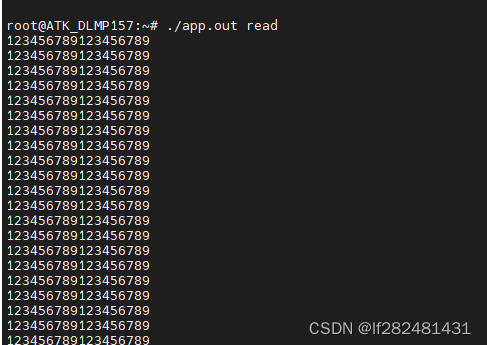多路复用简介
多路复用即同时等待多个IO,当某些IO发生相应的事件后则对其进行对应的操作。
应用层多路复用
在应用层可以通过poll、select、epoll来实现多路复用,在使用poll、select、epoll进行多路复用时强烈建议采用非阻塞方式打开相应的设备或文件,以免错误操作导致IO卡死
驱动层的多路复用框架
要使驱动支持多路复用只需要在驱动层实现对应的poll函数即可,如下是驱动中poll函数的固定框架:
unsigned int xxx_poll(struct file *filp, struct poll_table_struct *p)
{
unsigned int mask = 0;
//调用poll_wait,将进程加入到可能会改变进程状态的等待队列中,并将等待队列的信息添加到以poll_table扩
//展的数据结构中,此函数不会引起进程休眠
poll_wait(filp, &wq, p);
poll_wait(filp, &rq, p);
......
//如果发生读事件
//POLLIN 通常等价 POLLRDNORM ,表示发生读事件,即驱动有数据可读
if(...)
mask |= POLLIN | POLLRDNORM;
//如果发生写事件
//POLLOUT 通常等价 POLLWRNORM ,表示发生写事件,即驱动可以接受应用层数据
if(...)
mask |= POLLOUT | POLLWRNORM;
//返回相应的事件,没有发生任何事件则返回0
return mask;
}
驱动代码实现
驱动代码在上一章节的基础上进行修改,主要增加了poll函数,剩余部分基本相似,仅仅是修改了函数名而已,如下是这驱动程序的代码:
#include <linux/kernel.h>
#include <linux/module.h>
#include <linux/fs.h>
#include <linux/cdev.h>
#include <linux/miscdevice.h>
#include <linux/kfifo.h>
#include <linux/poll.h>
//次设备号,为MISC_DYNAMIC_MINOR表示自动分配
#define POLL_MINOR MISC_DYNAMIC_MINOR
//设备文件名
#define POLL_NAME "poll"
DEFINE_KFIFO(gfifo, char, 32);
//定义并初始化等待队列
DECLARE_WAIT_QUEUE_HEAD(read_queue);
DECLARE_WAIT_QUEUE_HEAD(write_queue);
//打开设备,对应应用层中的open
static int poll_open(struct inode *inode, struct file *file)
{
return 0;
}
//释放设备,在应用层最后因此调用close时调用
static int poll_release(struct inode *inode, struct file *file)
{
return 0;
}
//读数据,对应应用层中的read
static ssize_t poll_read(struct file *file, char __user *buf, size_t len, loff_t *pos)
{
unsigned int copied;
if(kfifo_is_empty(&gfifo))
{
// printk("fifo is empty\r\n");
//以非阻塞式打开,直接返回-EAGAIN
if(file->f_flags & O_NONBLOCK)
return -EAGAIN;
//挂起当前进程到等待队列,能被信号唤醒
if(wait_event_interruptible_exclusive(read_queue, !kfifo_is_empty(&gfifo)))
{
//返回-ERESTARTSYS,表示被信号唤醒
return -ERESTARTSYS;
}
}
//将FIFO中的数据读取到应用层
if(kfifo_to_user(&gfifo, buf, len, &copied) != 0)
{
printk("Bad address\r\n");
return -EFAULT;
}
//如果可以写入则唤醒写进程
if(!kfifo_is_full(&gfifo))
wake_up_interruptible(&write_queue);
return copied;
}
//写设备,对应应用层中的write
static ssize_t poll_write(struct file *file, const char __user *buf, size_t len, loff_t *pos)
{
unsigned int copied;
if(kfifo_is_full(&gfifo))
{
// printk("fifo is full\r\n");
//以非阻塞式打开,直接返回-EAGAIN
if(file->f_flags & O_NONBLOCK)
return -EAGAIN;
//挂起当前进程到等待队列,能被信号唤醒
if(wait_event_interruptible_exclusive(write_queue, !kfifo_is_full(&gfifo)))
{
//返回-ERESTARTSYS,表示被信号唤醒
return -ERESTARTSYS;
}
}
//将应用层的数据写入FIFO
if(kfifo_from_user(&gfifo, buf, len, &copied) != 0)
{
printk("Bad address\r\n");
return -EFAULT;
}
//如果有数据可读则唤醒读进程
if(!kfifo_is_empty(&gfifo))
wake_up_interruptible(&read_queue);
return copied;
}
static unsigned int poll_poll(struct file *filp, struct poll_table_struct *p)
{
unsigned int mask = 0;
//调用poll_wait,将进程加入到可能会改变进程状态的等待队列中,并将等待队列的添加到以poll_table扩展的数据结构中,此函数不会引起进程休眠
poll_wait(filp, &read_queue, p);
poll_wait(filp, &write_queue, p);
//如果发生读事件
//POLLIN 通常等价 POLLRDNORM ,表示发生读事件,即驱动有数据可读
if(!kfifo_is_empty(&gfifo))
{
// printk("read");
mask |= POLLIN | POLLRDNORM;
}
//如果发生写事件
//POLLOUT 通常等价 POLLWRNORM ,表示发生写事件,即驱动可以接收应用层数据
if(!kfifo_is_full(&gfifo))
{
// printk("write");
mask |= POLLOUT | POLLWRNORM;
}
//返回相应的事件,没有发生任何事件则返回0
return mask;
}
static struct file_operations ops = {
.owner = THIS_MODULE,
.write = poll_write,
.read = poll_read,
.poll = poll_poll,
.open = poll_open,
.release = poll_release,
};
static struct miscdevice poll_misc = {
.name = POLL_NAME,
.minor = POLL_MINOR,
.fops = &ops,
};
static int __init poll_init(void)
{
int err = 0;
printk("poll fifo init\r\n");
//注册混杂设备
err = misc_register(&poll_misc);
if(err != 0)
{
printk("register misc failed\r\n");
return err;
}
return 0;
}
static void __exit poll_exit(void)
{
printk("poll fifo exit\r\n");
//注销混杂设备
misc_deregister(&poll_misc);
}
module_init(poll_init);
module_exit(poll_exit);
MODULE_LICENSE("GPL");
MODULE_AUTHOR("csdn");
MODULE_DESCRIPTION("poll");
驱动测试程序实现
驱动测试程序使用函数来监测打开的设备文件描述符的状态,当发生POLLIN事件时调用read函数,读取驱动数据并提供printf输出,当发生POLLOUT事件是调用write函数将数据写入驱动,在程序开头还有一段判断工作模式的代码,工作在read状态关注POLLIN事件,否则关注POLLOUT事件,如下是整个驱动测试程序的代码:
#include <stdio.h>
#include <string.h>
#include <stdlib.h>
#include <sys/ioctl.h>
#include <sys/types.h>
#include <sys/stat.h>
#include <unistd.h>
#include <fcntl.h>
#include <errno.h>
#include <poll.h>
char rbuf[100] = {0};
char *wstr = "123456789123456789\r\n";
int main(int argc, char *argv[])
{
int fd;
int i;
int ret;
int is_read;
int write_index;
int str_lenght;
struct pollfd fds[1];
//确定工作模式,读或者写
if((argc >= 2) && (strncmp(argv[1], "read", 4) == 0))
is_read = 1;
else
is_read = 0;
write_index = 0;
str_lenght = strlen(wstr);
//打开设备,使用select、poll、epoll轮询设备状态时建议采用非阻塞方式打开设备
fd = open("/dev/poll", O_RDWR|O_NONBLOCK);
if(fd == -1)
{
perror("error");
return -1;
}
//将设备描述符加入pollfd列表,对于读操作只关心POLLIN事件,对于写操作只关心POLLOUT
fds[0].fd = fd;
if(is_read == 1)
fds[0].events = POLLIN;
else
fds[0].events = POLLOUT;
fds[0].revents = 0;
while(1)
{
//执行poll,轮询pollfd列表中的描述符,直到发生相应事件或者超时
ret = poll(fds, 1, -1);
if(ret == -1)
break;
//判断是否发生读事件,发生的事件存储在revents中
if(fds[0].revents & POLLIN)
{
//读数据,并通过printf输出
memset(rbuf, 0, 100);
ret = read(fd, rbuf, 99);
if(ret <= 0)
break;
printf("%s", rbuf);
fflush(stdout);
}
//判断是否发生写事件
if(fds[0].revents & POLLOUT)
{
//写数据
ret = write(fd, &wstr[write_index], str_lenght-write_index);
if(ret <= 0)
break;
write_index += ret;
if(write_index >= str_lenght)
write_index = 0;
}
}
//关闭设备
close(fd);
return 0;
}
上机实验
- 从这里下载代码并进行编译,然后拷贝到目标板/root目录
- 执行insmod poll.ko加载驱动
- 执行./app.out read启动测试程序,此时进行的read操作
- 在开一个终端执行./app.out启动测试程序,此时进行的是write操作
- 此时可看到执行./app.out read的终端在不停的输出读取到的数据























 2748
2748











 被折叠的 条评论
为什么被折叠?
被折叠的 条评论
为什么被折叠?








